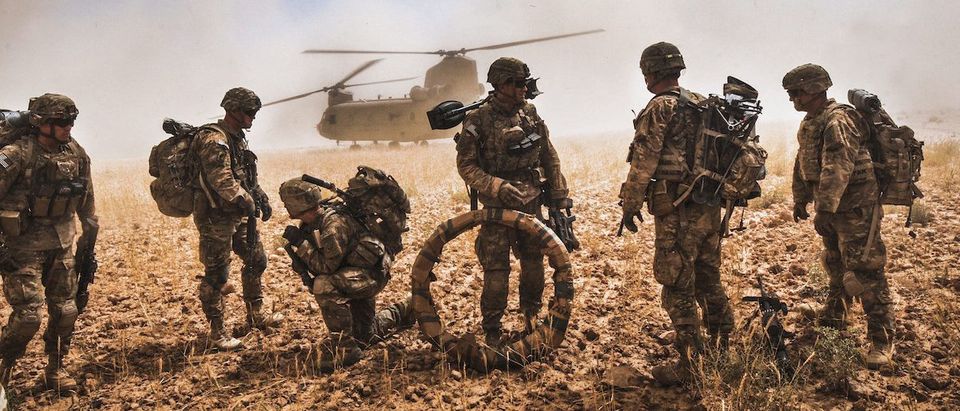If an epitaph is ever written about the U.S. military’s virtually endless and failing train, advise and assist program in Afghanistan, it will be “progress is being made.”
In his February 9, 2017 statement before the Senate Armed Services Committee, General John W. Nicholson, Commander of U.S. forces in Afghanistan, correctly defined the mission, but then made highly questionable comments regarding the “progress being made” accomplishing that mission.
“Our primary mission remains to protect the homeland by preventing Afghanistan from being used again as a safe haven for terrorists to attack the United States or our allies.”
After the defeat of the Taliban government in late 2001, the extent of U.S. military involvement, that is, troop levels and the operational tempo have always been predicated on a single proposition, to buy enough time so that Afghan security forces can successfully take the lead against the Taliban or any other terrorist entity who planned to use Afghanistan as a training or operational base.
That has been the raison d’être for the train, advise and assist component of the U.S. Afghanistan strategy, as Nicholson noted:
“Complementing the U.S. counterterrorism mission in Afghanistan is NATO’s Resolute Support Mission. This operation, the largest and longest in NATO’s history, focuses on training, advising, and assisting (TAA) the Afghan National Defense and Security Forces (ANDSF) and the Afghan Security Institutions (ASI) to achieve a secure and stable Afghanistan.”
“With the help of Resolute Support TAA and U.S. expeditionary advising and combat enablers, the ANDSF prevented the Taliban from achieving any of their major objectives.”
Despite that optimistic assessment, The New York Times reported:
“The commander of the American-led international military force in Afghanistan, warning that the United States and its NATO allies are facing a “stalemate,” told Congress on Thursday that he needed a few thousand additional troops to more effectively train and advise Afghan soldiers.”
That is, “progress is being made,” but…
In late 2010, after I returned from my final tour in Afghanistan, I wrote:
Last autumn [2009] the US government announced that after eight years and $27 billion, the results of the Afghan Army and Police training program were so bad that it was declared a failure. If the effectiveness of the training was ever questioned internally, it had no obvious effect. The ugly truth is that often mistakes will only be detected, if ever, long after the senior officers responsible for the fiascos have been promoted and have moved on. There is little incentive for doing better as long as the money keeps flowing, fresh troops keep arriving, and there is little demand for genuine accountability.
Contrary to the Pentagon’s rosy scenario described by Nicholson, the Taliban are winning.
On March 1, 2017, the Long War Journal (LWJ) reported that the “Taliban overran Tala Wa Barfak district in the northern province of Baghlan after besieging it for months.”
It is the second Afghan district to fall within a two-week period. Shorabak in Kandahar province was seized by the Taliban on February 21st, an area “where al Qaeda is known to have operated training camps.”
LWJ paints a grim picture of the situation in Afghanistan, identifying “44 Afghan districts under the Afghan jihadist group’s control, and another 56 that are heavily contested,” not just in Pashtun-majority areas but all across the country, but in provinces like Baghlan where Tajiks dominate.
Since October 2015, the number of Taliban controlled, influenced and contested districts has increased from 70 to 100 this month. The U.S.-supported Afghan government has lost control of 15% of the districts in just the last six months. In other words, the Taliban now control or threaten approximately 25% of the country. Not surprisingly, the Pentagon reports much lower numbers.
Since 2001, the initial counterterrorism mission combining covert and special operations with airpower evolved into a conventional-forces-based counterinsurgency strategy, which eventually ballooned into nation building.
Already in 2009, retired U.S. Army Major General Paul Vallely advocated returning to a cost-effective, flexible and “conditions-based” counterterrorism strategy, which he described in a Diana West article.
Vallely’s blueprint relies on the maximum use of unconventional forces, including Navy SEALS and other special operations units, which can be deployed as needed from what are known in military parlance as “lily pads”, that is, outposts or jumping-off points in friendly countries (Israel, Northern Kurdistan, India, Philippines, Italy, Djibouti) or from U.S. aircraft carrier strike groups. These lily pads eliminate the need for massive land bases such as Bagram Air Base in Afghanistan, now a small city, that needs to be continuously supplied and secured at enormous expense. The beauty of such an approach is that there are no long-term deployed forces and operations are conditions-based, meaning, we watch, we wait and when U.S. interests are threatened, we use our strike forces to take them out, target by target. This would work whether the threat came from Al Qaeda, Pakistani nukes or anything else.
It is an alternative certainly worth considering, rather than continuing to make progress doing the wrong things.
Lawrence Sellin, Ph.D. is a retired US Army Reserve colonel, a command and control subject matter expert, trained in Arabic and Kurdish, and a veteran of Afghanistan, northern Iraq and a humanitarian mission to West Africa. He receives email at lawrence.sellin@gmail.com.


